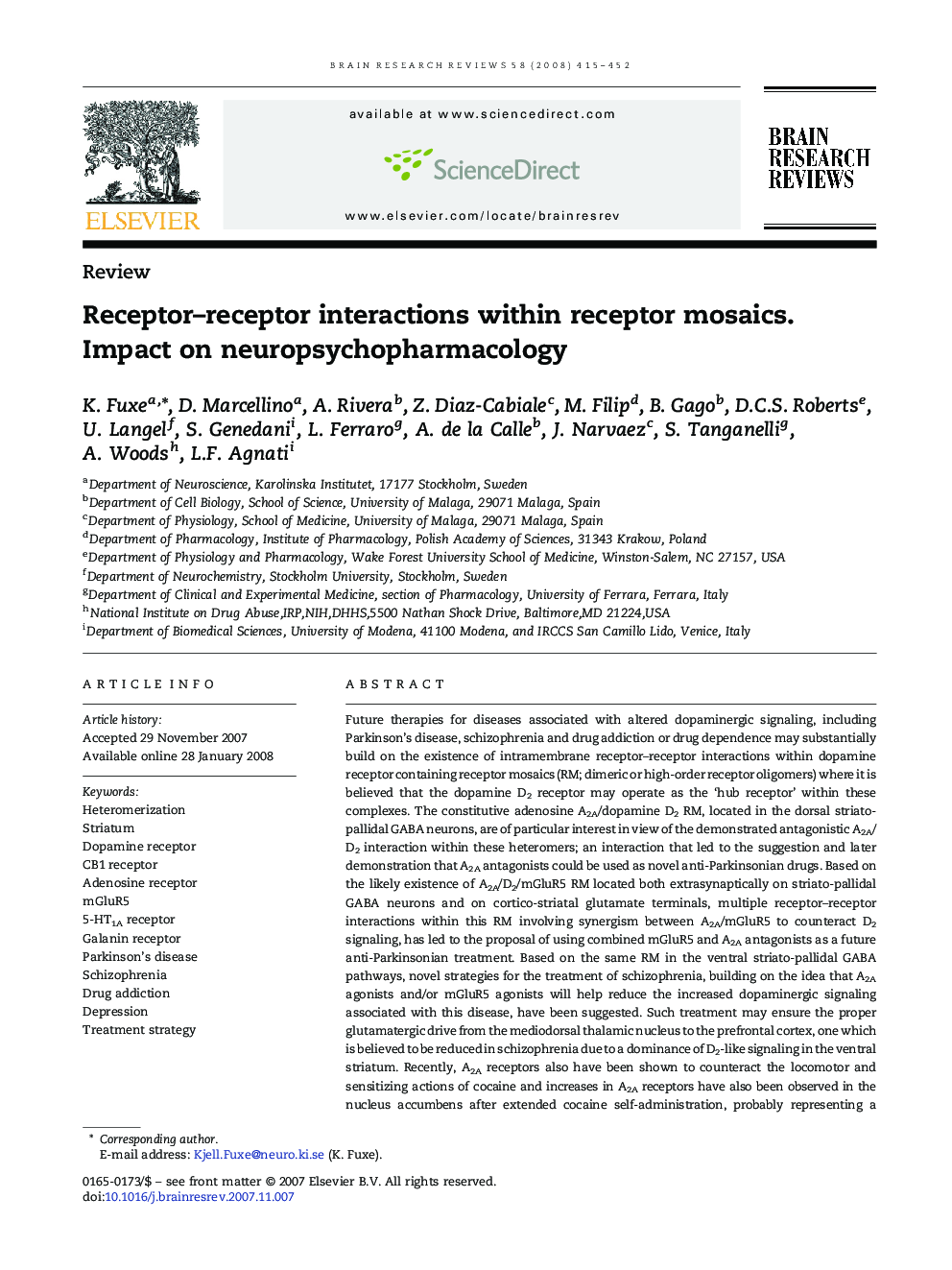| Article ID | Journal | Published Year | Pages | File Type |
|---|---|---|---|---|
| 4333873 | Brain Research Reviews | 2008 | 38 Pages |
Abstract
Future therapies for diseases associated with altered dopaminergic signaling, including Parkinson's disease, schizophrenia and drug addiction or drug dependence may substantially build on the existence of intramembrane receptor-receptor interactions within dopamine receptor containing receptor mosaics (RM; dimeric or high-order receptor oligomers) where it is believed that the dopamine D2 receptor may operate as the 'hub receptor' within these complexes. The constitutive adenosine A2A/dopamine D2 RM, located in the dorsal striato-pallidal GABA neurons, are of particular interest in view of the demonstrated antagonistic A2A/D2 interaction within these heteromers; an interaction that led to the suggestion and later demonstration that A2A antagonists could be used as novel anti-Parkinsonian drugs. Based on the likely existence of A2A/D2/mGluR5 RM located both extrasynaptically on striato-pallidal GABA neurons and on cortico-striatal glutamate terminals, multiple receptor-receptor interactions within this RM involving synergism between A2A/mGluR5 to counteract D2 signaling, has led to the proposal of using combined mGluR5 and A2A antagonists as a future anti-Parkinsonian treatment. Based on the same RM in the ventral striato-pallidal GABA pathways, novel strategies for the treatment of schizophrenia, building on the idea that A2A agonists and/or mGluR5 agonists will help reduce the increased dopaminergic signaling associated with this disease, have been suggested. Such treatment may ensure the proper glutamatergic drive from the mediodorsal thalamic nucleus to the prefrontal cortex, one which is believed to be reduced in schizophrenia due to a dominance of D2-like signaling in the ventral striatum. Recently, A2A receptors also have been shown to counteract the locomotor and sensitizing actions of cocaine and increases in A2A receptors have also been observed in the nucleus accumbens after extended cocaine self-administration, probably representing a compensatory up-regulation to counteract the cocaine-induced increases in dopamine D2 and D3 signaling. Therefore, A2A agonists, through antagonizing D2 and D3 signaling within A2A/D2 and A2A/D3 RM heteromers in the nucleus accumbens, may be found useful as a treatment for cocaine dependence. Furthermore, antagonistic cannabinoid CB1/D2 interactions requiring A2A receptors have also been discovered and possibly operate in CB1/D2/A2A RM located principally on striatal glutamate terminals but also on some ventral striato-pallidal GABA neurons, thereby opening up a new mechanism for the integration of endocannabinoid, DA and adenosine mediated signals. Thus, A2A, mGluR5 and/or CB1 receptors can form integrative units with D2 receptors within RM displaying different compositions, topography and localization. Also galaninR/5-HT1A RM probably participates in the transmission of the ascending 5-hydroxytryptamine neurons, where galanin receptors antagonize 5-HT1A recognition and signaling. Subtype specific galanin receptor antagonists may therefore represent novel antidepressant drugs. These results suggest the importance of a complete understanding of the function of these RM with regard to disease. Ultimately receptor-receptor interactions within RM that modify dopaminergic and serotonergic signaling may give new strategies for treatment of a wide range of diseases associated with altered dopaminergic and serotonergic signaling.
Keywords
Related Topics
Life Sciences
Neuroscience
Neuroscience (General)
Authors
K. Fuxe, D. Marcellino, A. Rivera, Z. Diaz-Cabiale, M. Filip, B. Gago, D.C.S. Roberts, U. Langel, S. Genedani, L. Ferraro, A. de la Calle, J. Narvaez, S. Tanganelli, A. Woods, L.F. Agnati,
